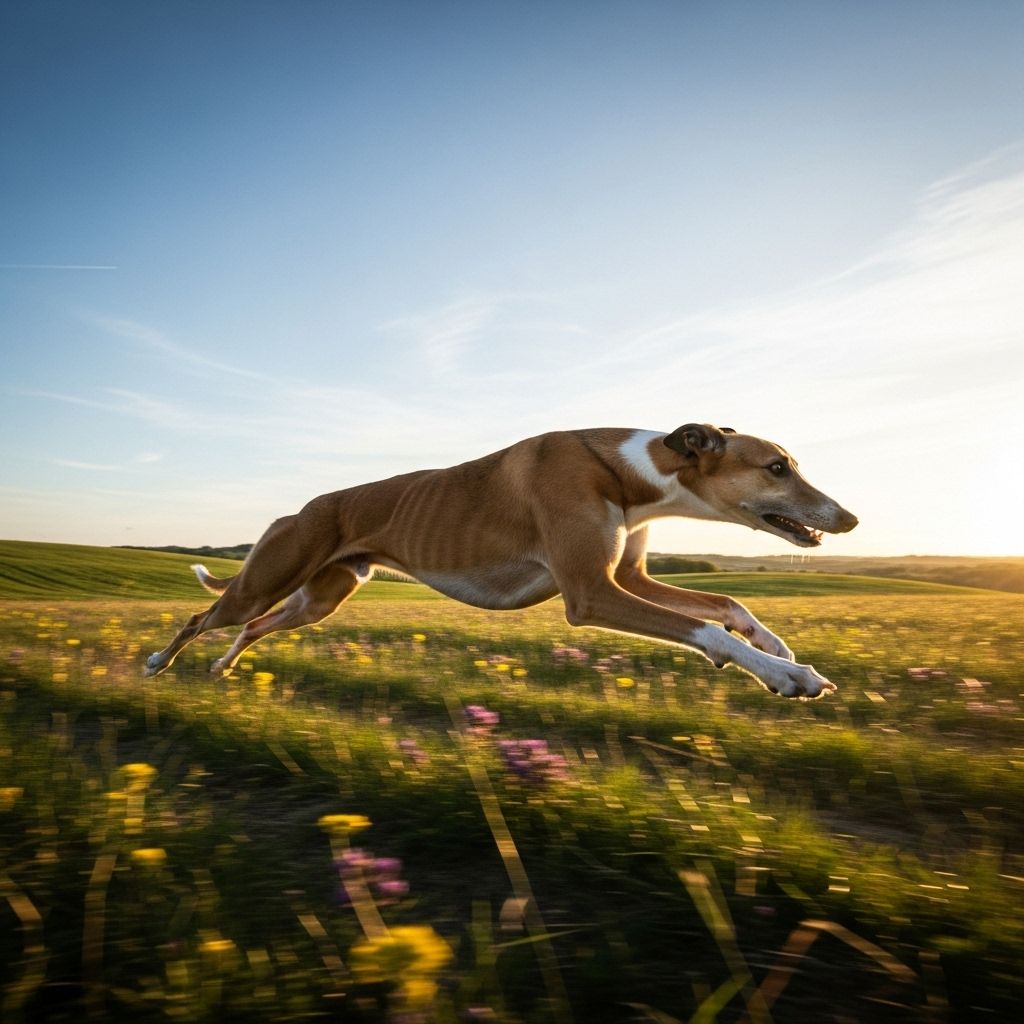How Fast Can A Dog Run? Guide To Breed Speeds & Safety
Explore the science and wellness tips helping four-legged athletes thrive on every jog.

How Fast Can a Dog Run? Breed Speeds, Science & Fun Facts
Dogs amaze us with their agility, energy, and zest for running. But have you ever wondered just how fast dogs can really run, how breed or body shape makes a difference, or whether your furry friend could keep pace on your next jog? Read on for the science, breed-by-breed statistics, and smart tips for running safely with your dog.
How Fast Can Dogs Run?
It’s no secret that dogs are fast—the question is: How fast?
- Most healthy dogs can reach speeds of 15–20 miles per hour (mph) in short bursts.
- Certain breeds, especially sighthounds, can reach up to 45 mph, rivaling wild animals in short-distance sprints.
- For comparison, the average human can run 5–8 mph, with elite athletes like Usain Bolt peaking at 27 mph.
Dog running speeds are shaped by genetics, build, body composition, and overall health. Some breeds are made for sprinting, others for distance or endurance, and a few are content with a slow, steady pace. Veterinary experts note that a dog’s individual speed will vary depending on their health, size, and age, so always consider your dog’s unique needs before lacing up your running shoes together.
Running Speed by Breed
Curious how your dog’s speed compares to the canine champions? Here’s a breakdown of the fastest, average, and slowest breeds. Note the wide variation:
| Dog Breed | Average Top Speed (mph) |
|---|---|
| Greyhound | 45 |
| Vizsla | 40 |
| Borzoi | 36 |
| Dalmatian | 37 |
| Jack Russell Terrier | 38 |
| Border Collie | 30 |
| German Shepherd | 30 |
| Boxer | 30 |
| Whippet | 35 |
| Labrador Retriever | 20–30 |
| Basset Hound | 5–10 |
| Shih Tzu | 6 |
As you can see, speed varies widely within the canine family. Fast breeds like Greyhounds and Whippets feature lean bodies and long legs, while shorter-legged, heavier breeds (such as Basset Hounds or Shih Tzus) top out at much lower speeds.
The Fastest Dog Breeds on Four Paws
Let’s take a closer look at the canine speed champs and what makes them special:
- Greyhound: The undisputed speed king, bred for racing and hunting, built for short, explosive sprints at up to 45 mph. Their slim frame and deep chest enable maximal stride length and speed.
- Vizsla: Agile and athletic, Vizslas hit about 40 mph. Their background as hunting dogs gives them both speed and stamina for long runs.
- Jack Russell Terrier: Small but mighty, these energetic terriers can reach up to 38 mph, thanks to their powerful muscles and boundless energy.
- Dalmatian: Known for their history as carriage dogs, Dalmatians can sprint up to 37 mph and maintain high endurance over distance.
- Borzoi: Also called Russian Wolfhounds, Borzois clock in around 36 mph and were bred to chase swift prey across open terrain.
- Border Collie & German Shepherd: Both breeds can approach 30 mph or more, renowned for their agility, intelligence, and versatility as working dogs.
The Slowest Dog Breeds
Not every dog is made for the race track. Some breeds excel at affection, cuddling, or short walks instead.
- Basset Hound: Built for scent-tracking, not speed, and typically run just 5–10 mph.
- Shih Tzu: The slowest reported breed, averaging only 6 mph. Perfect for gentle strolls instead.
- St. Bernard & Bulldog: Heavier, large-boned breeds that tend to tire quickly and are not suited for running. They’re happier with steady, slow-paced activity.
What Makes Some Dogs Run So Fast? The Science of Canine Speed
The canine body is a marvel of speed and agility. Here are the key anatomical and evolutionary factors that give dogs their supercharged running ability:
- Flexible Spine: A dog’s spine is long, supple, and able to contract and lengthen with each stride—similar to the cheetah, the fastest land animal. This lets them stretch their body out fully during sprints.
- No Collarbone: Dogs (like most quadrupeds) have no true collarbone, which lets their front limbs swing freely and lengthen each stride.
- Long Limbs and Powerful Muscles: Fast breeds are often leggy with deep chests and well-developed leg muscles, all optimized for explosive power.
- Grippy Paw Pads: Provide traction for fast take-offs and sharp turns.
- Large Heart and Lungs: Especially in sighthounds, these organs provide an abundance of oxygen during high-speed chases.
Many of these traits were honed through centuries of selective breeding for tasks like hunting, chasing, or herding. So while all dogs benefit from this athletic heritage, the fastest dogs are true products of evolutionary design.
Factors That Influence Dog Running Speed
- Breed Genetics: Built-in traits like leg length, lung capacity, and muscle type set fundamental speed limits.
- Age: Young adult dogs are usually fastest, with speed decreasing as they enter senior years.
- Health & Fitness: A healthy, fit dog will be faster and have more stamina than an overweight or sedentary one.
- Motivation/Drive: Some dogs run fastest when chasing prey, playing, or being called by their favorite human.
- Training Habit: Dogs that regularly run or play are naturally better conditioned for sprints and distance.
Can Dogs Run Long Distances?
Speed isn’t everything—while some dogs are natural sprinters, others are built for endurance. Here’s what to consider:
- Sighthounds (like Greyhounds & Whippets): Elite sprinters, but tire quickly; not suited for distance running.
- Herding breeds (like Border Collies & Australian Shepherds): Can maintain a moderate pace over many miles, making excellent jogging partners.
- Retrievers & other working dogs: Also good for endurance, as long as they’re in good health and properly conditioned.
- Larger, heavy breeds: Usually best at short, moderate-paced walks.
Tips for Running Safely with Your Dog
- Start Slow: Especially if your dog is young, new to running, or has been inactive for a while.
- Warm-Up & Cool Down: Just like humans, dogs benefit from gentle warm-ups and cool-downs to prevent injury.
- Check the Weather: Avoid running in extreme heat or humidity. Dogs can easily overheat, as they don’t sweat like humans.
- Hydration: Bring water for both yourself and your dog, and offer regular breaks.
- Watch for Fatigue: Pay attention to signs like heavy panting, slowing down, or reluctance to continue. Stop immediately if your dog limps or shows signs of injury or heat stress.
- Gear Up: Choose a comfortable leash, harness, and consider paw protection on hot pavement or rough terrain.
- Follow Breed-Specific Limits: Don’t expect a slow, heavy, or flat-nosed breed to run far or fast. Always check with your vet before taking up running with your dog, especially if you’re unsure.
How to Tell If Your Dog Enjoys Running
- Wags enthusiastically when you pick up the leash.
- Trots ahead or strides confidently beside you.
- Recovers quickly after a run, looking happy and energetic.
- Shows no signs of discomfort, limping, or excessive fatigue.
Remember: a dog who prefers sniffing, meandering, or moving at their own pace may not have the temperament or body for structured running, and that’s perfectly fine!
Fun & Surprising Facts About Canine Speed
- Dogs’ fastest running style is called a double-suspension gallop, where all four feet leave the ground twice per stride (much like a cheetah).
- The Greyhound is not just a fast canine; it’s the second fastest land animal after the cheetah.
- Short-nosed breeds, like Bulldogs, can have breathing difficulties if pushed too hard or in hot weather—keep “speed” runs brief or avoid entirely.
- The world’s fastest recorded canine: The Greyhound, widely used in racing circuits worldwide for their unmatched speed.
Frequently Asked Questions (FAQs)
Q: What is the average running speed for most dogs?
A: Most dogs can run at speeds between 15 and 20 mph in short bursts, depending on their breed, age, and health.
Q: Which dog breed is the fastest runner?
A: Greyhounds are the fastest dog breed, capable of reaching up to 45 mph in short, explosive sprints.
Q: Can all dogs run?
A: While most dogs can run, their natural pace and stamina vary by breed and individual. Some breeds (like Basset Hounds and Shih Tzus) prefer walking, while others love to sprint or jog.
Q: Is it safe to run long distances with my dog?
A: Only if your dog is healthy, conditioned, and appropriate for endurance work. Always consult your veterinarian first, especially if your dog is a senior, a large/giant breed, or brachycephalic (short-snouted).
Q: How can I make sure my dog enjoys running with me?
A: Start gently, observe your dog’s enthusiasm, and pay close attention to signs of fatigue or discomfort. Keep runs short at first and increase distance gradually while monitoring your dog’s health and happiness.
Key Takeaways
- The average dog can run 15–20 mph; Greyhounds are the fastest at 45 mph.
- Breed, health, age, and anatomy shape a dog’s top speed.
- Not all dogs are built for distance or speed—always consider individual ability before running.
- When running with your dog, start slow, prioritize safety, and have fun!
References
Read full bio of Anjali Sayee












